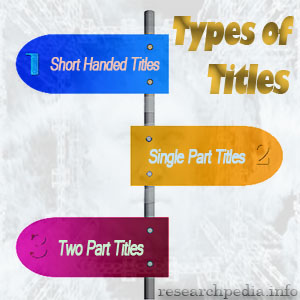Types of Title

The consequences and implications of a title cannot be underestimated either so as its different types. The proper use of the title not only portrays your view but also gives a good knowledge of the respected literature.
Importance of a Research Title:
A great title increases the chances of you writing a great research paper or thesis become easy and you can concentrate on more important parts of your documents. Title acts as a doorway to the ideas, your audience knows what they are about to read when they come across your title. It directs viewers who are interested in your subject to your research. An efficient title alerts reader to the paper’s topic and can be used to get readers in the right frame of mind. Titles can be classified into three different types.
1. Short-Handed Titles:
- Acronyms and shortened structured titles in general, are to be spelled out.
- These kinds of titles are usually not used for research papers or theses.
- They are usually used for famous terms and models.
- For example, Information Retrieval as IR, Machine Learning as ML, Hidden Markov Model as HMM, Potassium Mangan cyanide as K3 Mn(CN)6, Minnesota Multiphasic Personality Inventory as MMPI and Teaching English as a Second Language as TESL.
2. Single Part Titles:
- As the name indicates it consists of a single phrase
- It usually doesn’t require any colons or any additional details.
- Such types of titles increase visibility, and readability and are easy to learn.
- But at the same time, it is very hard to rank such titles so research may be left out and might not receive its due appreciation.
- Examples of such titles are:
- Plastic in Marina trench: A threat to human existence.
- Dark matter: A hidden universe.
- Gene Editing: A revolution in the field of medicine.
3. Two Part Titles:
- Two-part titles consist of two phrases usually attached using a colon.
- One part highlights the topic, followed by a colon and a subtitle containing more precise information or brings specificity to the title.
- This title type is an accepted method for titling research papers and academic theses.
- For example
- “Geocasting in mobile ad hoc networks: Location-based multicast algorithms”
- Microplastic in marina Ecosystem: Impact, distribution and potentially harmful effects on a human being.
- It provides clarity to your research topic. It is easy to rank in search engines and It provides more precise knowledge about the topic while if we compare it with a single-part title, the details are lacking as compared to this one.
Tips for Writing an Amazing Research Title:
Following are some tips that you can follow and write eye-catching research titles:
- Your title should be concise.
- Focus on clarity.
- The main theme of your research should be indicated in your title.
- Be specific about your title.
Conclusion:
The title is the first thing that readers see when they are searching for new research. Always focus and work on a title because the foundation of your research lies in a good title.


which type is good for database research papers title